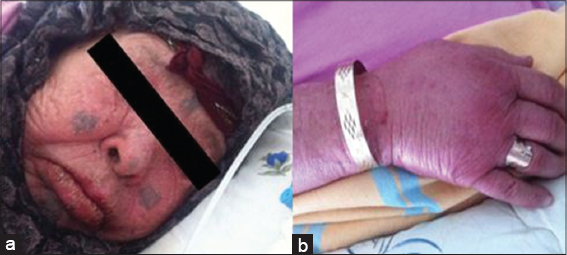Drug Reaction with Eosinophilia and Systemic Symptoms (DRESS) syndrome with ciprofloxacin
Sameh Sayhi , Tayssir Ben Achour
, Tayssir Ben Achour
Internal Medicine Department, Military Hospital of Tunis, Tunis, Tunisia
Corresponding author: Dr. Sameh Sayhi, E-mail: sameh_sayhi@yahoo.fr
Submission: 22.05.2019; Acceptance: 23.07.2019
DOI: 10.7241/ourd.20202.21
Cite this article: Sayhi S, Achour TB. Drug Reaction with Eosinophilia and Systemic Symptoms (DRESS) syndrome with ciprofl oxacin. Our Dermatol Online. 2020;11(2):189.
Citation tools:
Copyright information
© Our Dermatology Online 2020. No commercial re-use. See rights and permissions. Published by Our Dermatology Online.
Drug Reaction with Eosinophilia and Systemic Symptoms (DRESS) syndrome is a severe adverse drug-induced reaction, characterized by generalized skin rash associated with hypereosinophilia and organ involvement [1]. The syndrome is most frequently caused by allopurinol, antiepileptics [2], and antibiotics (sulfamethoxazole, dapsone, minocycline, and vancomycin). Dress syndrome associated with ciprofloxacin is rare.
We report the observation of 88-year-old women hospitalized for urinary tract infection treated by ciprofloxacin 1.5g/d. seven days later, the patient presented generalized erythematous lesions associated with pruritus, edema of the hands and cheilitis (Figs. 1a and 1b). Biological tests objectified renal and hepatic impairment. An elevated eosinophil count was objectified: 51380 cells/mm3. Pharmacovigilance survey was carried out confirming the drug origin. Ciprofloxacin was stopped and the patient was treated by corticosteroids with favorable outcome.
 |
Figure 1: a and b Cheleitis and hand edema in women with DRESS syndrome (ciprofloxacin). |
DRESS syndrome is a serious and potentially life-threatening toxic epidermis due to multi-visceral involvement. In most of the above described cases, systemic corticosteroids were used with success.
REFERENCES
1. Kaabi W, Zaiem A, Aouinti I, Charfi O, Kastalli S, El Aidli S, et al. Drug reaction with eosinophilia and systemic symptoms in pediatric patients:A clinicopathological study of 16 cases in the National Center of Pharmacovigilance of Tunisia. Therapie. 2019;(19):595730063-0.
2. Shear NH, Spielberg SP. Anticonvulsant hypersensitivity syndrome. In vitro assessment of risk. J Clin Invest. 1988;82:1826-2.
Notes
Source of Support: Nil.
Conflict of Interest: None declared.
Request permissions
If you wish to reuse any or all of this article please use the e-mail (brzezoo77@yahoo.com) to contact with publisher.
| Related Articles | Search Authors in |
|
|



Comments are closed.